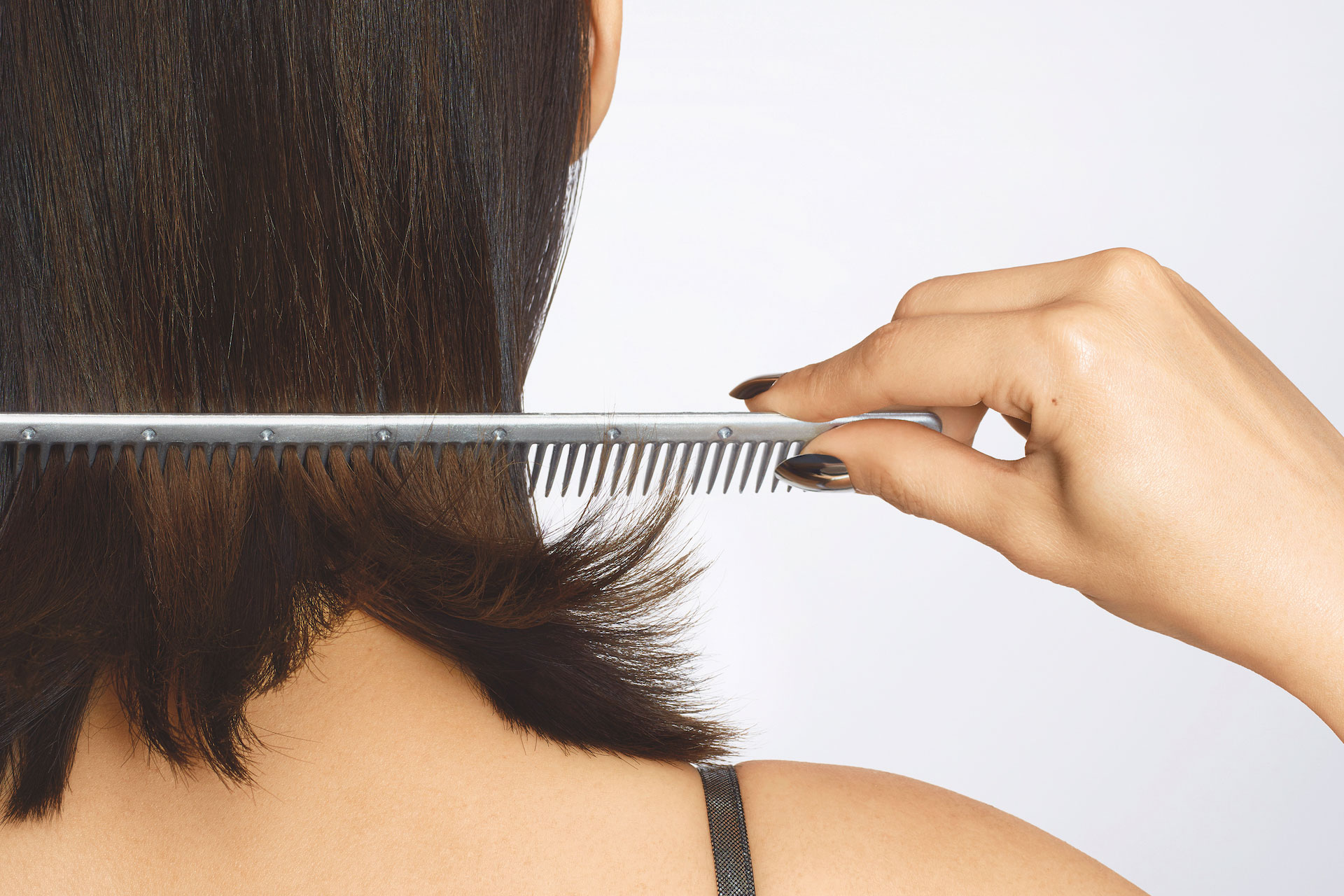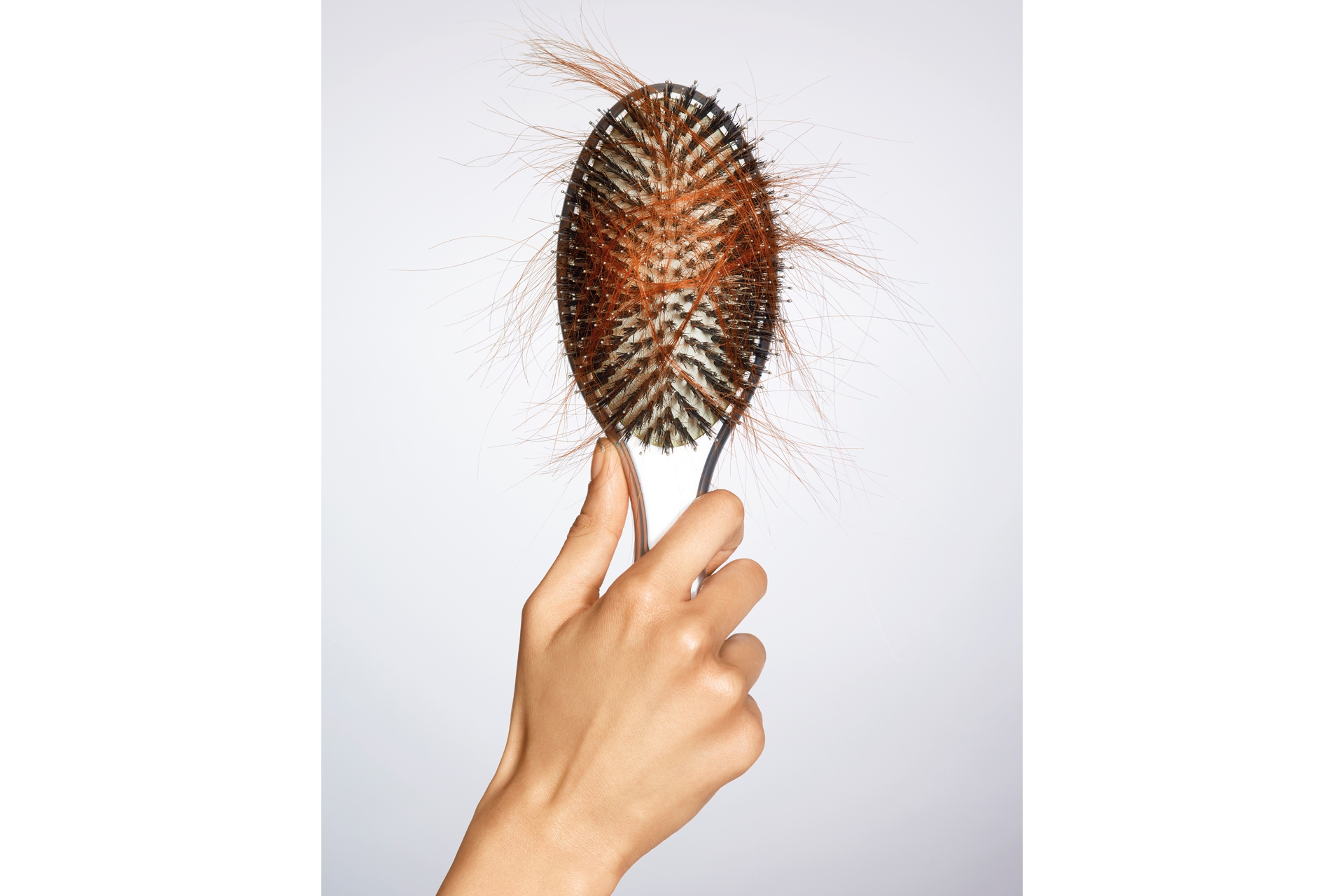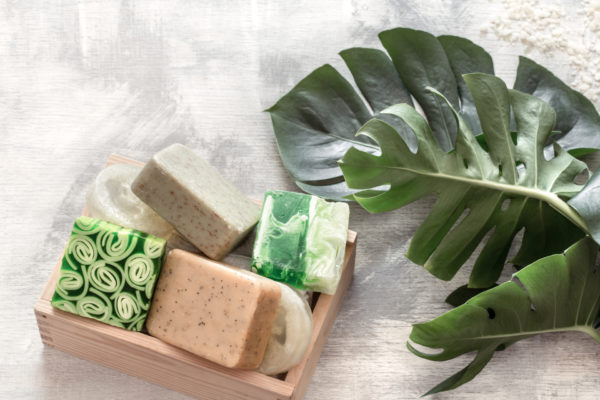Female Hair Loss: The Solutions That Really Work
By
2 years ago
Hair today, gone tomorrow

Female hair loss is the latest taboo to break. But how do we know what really works? Brigid Moss has tried (almost) all the solutions – and she has the expert verdict for you.
Main image photography, Matthew Shave; styling and art direction, Ursula Lake
How to Tackle Female Hair Loss

Now we’re openly talking about the menopause, the next taboo to break is female hair loss. It affects 40 percent of women up to the age of 50, and up to 60 percent after that. But despite it being a common female experience, it’s often tinged with shame and dealt with in secret.
Like a lot of women, I noticed I was losing hair in my mid-40s, an extra bonus to go with the hormonal havoc of perimenopause. Functional medicine GP Dr Klaudia Raczko, who specialises in hormones, explains: ‘In general, your body does not like hormonal fluctuations, and so they can have an impact on the hair follicles.’ Having been blessed in my 30s with an abundance of hair, by the age of 45 I was like a labrador in spring, leaving a trail of hair behind: the car seat, my cardigan, the yoga mat.
It was miserable and I couldn’t tell anyone. It was only during the pandemic that I realised it wasn’t just me. Due to stress, hair loss went up and people began to discuss it, subsequently leading to a boom in home and salon treatments. Latest figures from 2021 estimate the global market to now be worth several billion dollars.
‘Female hair loss has been such a taboo topic for so many years, so there is a lot of mystery surrounding it. Women feel they are alone, and that can be really scary,’ says Anabel Kingsley, trichologist and brand president of Philip Kingsley clinics (philipkingsley.co.uk). ‘Now we are having many more conversations about it. And yet, there’s a flipside; there’s a lot of misinformation being spread.’
Why Does Women’s Hair Thin?
Most women will have more than one reason for hair loss. That was the case for me too. As well as menopause, I am sure stress played (and is playing) a big part; the stress hormone cortisol steals the raw materials we need to make hair-friendly oestrogen and progesterone, according to nutritionist Pippa Campbell, author of Eat Right, Lose Weight. She diagnosed me with a borderline underactive thyroid plus anaemia and very low ferritin (iron stores), low levels of vitamin B12 and vitamin D. ‘These are some of the most common nutrient shortages that affect hair growth,’ she says, ‘and I’d also add zinc and folate. I often check iodine and selenium levels too, as they are so important for thyroid function. Even borderline underactive thyroid may lead to hair loss. Clues are feeling tired, having cold hands and feet, finding it hard to lose weight and the outer third of your eyebrows going missing.’
Whereas illness and nutritional deficiencies such as those mentioned tend to cause shedding all over the scalp, hormonal or female pattern hair loss (FPHL) tends to be at the temples, hairline, parting and/or crown. The latter is driven by male hormones, specifically DHT, a breakdown product of testosterone. Women in their 20s and 30s with polycystic ovaries often lose hair due to high levels of testosterone and DHT. But from the perimenopause onwards, hair loss tends to be based on genetic factors. ‘It’s not that testosterone is too high,’ says Kingsley, ‘it’s that hair follicles are overly sensitive to DHT.’
There are two other kinds of hair loss that I don’t have. ‘The most common type I see in women is traction alopecia from hair styling such as a tight ponytail, as well as chemical straightening,’ says hair transplant surgeon Dr Chris D’Souza. The final kind is alopecia caused by autoimmune conditions, where the immune system mistakenly attacks the follicles; this tends to be the hardest kind to treat.
Topical Solutions for Female Hair Loss
In the year since I’ve started to investigate hair loss seriously, all the experts I’ve spoken to describe seeing people in clinic who’ve been misdiagnosed. To eliminate this, I took the Fagron TrichoTest with hair transplant surgeon and aesthetic doctor Dr Munir Somji. It identifies hair loss related genes and from this, can advise which type of treatment you’ll respond to. ‘It can test if you’ll respond to biotin, the B vitamin which is in most supplements but 50 percent of people don’t have the enzyme to make use of it,’ says Dr Munir. ‘It can also tell you if it is worth supplementing with collagen.’ The most useful thing the Fagron test reveals is whether you’re one of the 70 to 80 percent of people who respond to minoxidil (Regaine), the only UK licensed medication and first line treatment for FPHL at most clinics. Minoxidil increases blood flow to the follicles and works against DHT. A good tip: if you buy it at a chemist, use the five percent men’s version once a day, rather than the two percent version for women twice a day. Some doctors – including Dr Munir – prescribe up to ten percent.
At the Philip Kingsley clinic, the main treatment is minoxidil plus a personalised mix of oestrogen and progesterone. ‘It’s like HRT for the scalp,’ says Anabel Kingsley. One downside of minoxidil and, in fact, all treatments for genetic FPHL is that you need to keep using them. Some people find it easier to take a pill; the option here is spironolactone, an anti-androgen. Its NHS use is as a diuretic, but Dr Munir prescribes it off label as it stops follicles being as responsive to DHT.
There are also natural ingredients that have been shown to work. A 2015 study showed that rosemary oil was as effective as two percent minoxidil in women and people rave about it, not least on TikTok. The entrepreneur Ama Amo-Agyei launched Plantmade, a range of hair treatments, to deal with her own hair loss. It’s based on ayurvedic ingredients. She says customers have reported the range working for all kinds of hair thinning, including traction, androgenic and stress-related hair loss.
Another at-home therapy with some evidence behind it is low-level laser therapy (LLLT). Lily Earle, daughter of beauty pioneer Liz Earle, sells the Cellreturn Hair Alpha-Ray helmet (cellreturn.co.uk), a device designed in South Korea. Its infra-red and red lights increase blood flow – and so nutrition – to follicles. One study on men and women with androgenetic alopecia showed that using it for 20 minutes a day led to an increase in hair density of 25 percent over six months. At just a fraction under £2,000, it’s not for the faint-hearted. Other studies suggest that simply massaging your head can improve circulation and so, over time, hair density too; ‘anything that improves blood flow is a good idea,’ says Dr Munir.
Can Needling, Stem Cells and Growth Factors Help Female Hair Loss?
Another approach is to create tiny wounds in the skin, provoking a healing response that kick-starts follicles. The easiest way to do this is with a derma roller, once or twice a week. Adding growth factors and follicle-feeding nutrients super-charges the effect. During The Rapunzel Method at EF Future Health (from £1,995 for five sessions, ef-futurehealth.com), your scalp is first derma-rolled, then the therapist applies a solution containing growth factors that feed the follicle’s stem cells. You’re sent home with the Monpure scalp health haircare range, including a scalp exfoliator.
The original and still-worth-having treatment in this category is platelet-rich plasma (PRP) therapy, aka the vampire facial. You donate a vial of blood that’s spun in a centrifuge to separate out the plasma, which is then needled back into the scalp. On average, says Dr Wassim Taktouk, three to six months is all it takes, and results will last 18 to 24 months (costs from £650, drwassimtaktouk.com).
Calecim is a new extract of stem cells from the umbilical cord lining of red deer. The stem cells signal follicles to grow; studies show more follicles plus a 30 times reduction in inflammatory signals, a leading contributor to follicle death. A course is two treatments a week for six weeks; you can also do this at home (from £315 at drmedispa.com).
The most futuristic treatment is with exosomes, healing and signalling molecules that are currently being developed in the medical field as a delivery system for cancer drugs. Dr Shameema Damree first uses radiofrequency microneedling to open channels so the exosomes can reach the follicles then applies a solution filled with these potent molecules. A course of five of Dr Damree’s RF and exosome treatments (£950, evocyte.co.uk) is recommended to reboot the hair’s growth cycles.
Tattoos and Transplants for Hair Loss
A clever way to disguise hair loss that’s emerged out of the brow microblading technique is scalp micropigmentation.
It works well on dark hair, giving the illusion of a less visible scalp by camouflaging where hair is sparse (from £2,000, thedsouzaclinic.com). Hair transplants are on the rise in women, too. Dr D’Souza says, ‘People are becoming more aware that a transplant is possible, and it’s become more mainstream too.’ At Dr Munir’s clinic, 95 per cent of his transplant clients are women. Transplants became more appealing to women with the advent of the Follicular Unit Extraction (FUE) technique, which involves implantation of individual follicles. Unlike the original Strip (Follicular Unit Transplantation or FUT) technique, where the transplant areas have to be shaved, FUE makes it possible for hairs to keep their length. Good candidates for both must have enough hair in the donor site, usually at the back of the head. To be a candidate for a hair transplant you need plenty of possible donor follicles. At an average price of around £7,000, with two weeks of downtime, it’s a big decision.
What’s frustrating about treating hair loss is the time it takes to reap the results – up to six months is average – therefore, real change can be imperceptible, especially if you are concurrently making lifestyle changes that could also have a positive impact. I’m not saying never on the hair transplant. It may be a major investment, but not having to worry about thinning hair could well be the best money I’ll spend yet. Time will tell.










